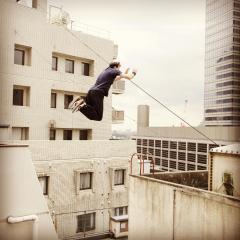Bobby Gordon-Smith started practicing Parkour before he even knew it existed. By the time he discovered that there was a whole community of traceurs, he was hooked. Bobby is now an affiliate coach at Parkour Generations, and coaches weightlifting when he’s not busy with Parkour. We chatted to Bobby about his Parkour life.
How long have you been a traceur?
I have been training for about 9 years officially. But I was always practicing climbing and jumping from a young age – I watched one too many Jackie Chan movies.
Why did you take up Parkour?
I was told about these people who practice movement (running, jumping, climbing) and that they called it Parkour. It inspired me to carry on practicing some of the things I had been doing. It didn’t occur to me for a long time to look it up on the internet, but when I did, I found a handful of people doing the same thing.
How do you prepare before you start a Parkour session? And what do you do afterwards to recover?
I would usually do a general warm up which would include light jogging, jumping and some dynamic mobility drills. Then I start drilling the basic techniques found in Parkour, progressively increasing the difficulty and impact of the drills. After a few weeks of training your body begins to adapt to the physical demands of Parkour. When you start out it’s normal to get a lot of muscle soreness, especially in the legs. The best advice I can give about recovery is to allow an appropriate amount of time between heavy sessions and try doing some light movement on your off days. Eventually you should find that you can train more frequently.
Where is your favourite location to practice Parkour?
Anywhere that has a lot of rails and walls is good for drilling basic techniques. But I see potential for different movements everywhere I look.
Would you say that Parkour has a strong accompanying culture, e.g. music or fashion?
When I started out, there was no deliberate attempt to look a certain way for Parkour. We just wore the clothes that we thought would be most suitable for training. It probably has developed into a bit of a look now though: £5 tracksuit bottoms with blood on them and whatever good shoes are available at the time. It seems to draw in an interesting array of people though, from “extreme sports” kids to quite intense people who practice moving in an almost religious way…and everyone in between. I wouldn’t say there’s one type of person who does Parkour, but it’s probably slowly heading the way of other “extreme sports”, which is a shame I think.








